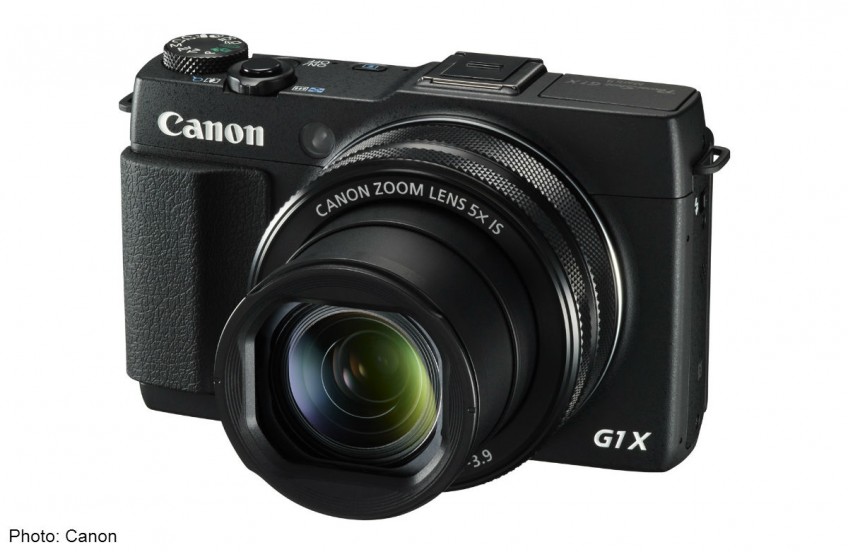Review: Canon PowerShot G1X Mark II

It has been two years since Canon released the PowerShot G1X prosumer compact camera to counter the rise of mirrorless cameras.
The G1X's 1.5-inch CMOS image sensor is about 16 per cent bigger than the sensors of Micro Four Thirds mirrorless cameras.
But it was not without glitches, including a slow lens and a 20 cm macro focusing distance that was an embarrassment.
Now, the Mark II is here and it addresses some of these issues.
Canon's PowerShot G1X Mark II has a smaller megapixel count than the 14.3 megapixels of the original. But it delivers 12.8-megapixel images in 3:2 aspect ratio (like in 35mm film) and 13.1-megapixel images in 4:3 aspect ratio (as in standard TV and monitors).
Its 5x optical zoom lens has a focal range of 24-120mm with a big f/2.0 aperture at 24mm and an f/3.9 at 120mm, a welcome improvement from the 28-112mm f/2.8-f/5.8 lens of the original.
Unlike the rotating LCD screen of the original, the Mark II's 3-inch touchscreen LCD can be flipped down only by 45 degrees. But as the display is now a touchscreen and can be flipped up by 180 degrees, it is great for selfies.
Rock solid and ergonomic body
The Mark II looks very much like the original. The metallic body feels rock solid and has a comfortable rubberised grip.
But the near-useless optical viewfinder of its predecessor is gone. Instead, you have the option of fixing an electronic viewfinder (EVF), the EVF-DC1 ($379), on the hot shoe of the Mark II.
The EVF-DC1 features a 2.36-million-dot LCD and is tiltable up to 90 degrees. To take the EVF off the hot shoe, you have to press a button on the side. This prevents accidental slippage. I found the EVF-DC1 to be almost as good as the optical view finder of a DSLR and definitely way better than that of the G1X's, with its oft-blocked view.
The layout of buttons and dials has been changed. The top exposure compensation dial is gone and the top Mode dial has been moved to the extreme right.
The top control dial that sat above the grip is also gone. Instead, there are now two control rings around the lens. Both control rings have a metallic feel for easy turning.
The inner ring is for adjusting settings. It clicks as it is turned, just like adjusting the aperture on old lenses.
The outer ring turns more freely and is for manual focusing and other customisable settings, including zooming of the lens.
So, one ring can be customised to adjust the aperture and the other is for shutter speed in Manual mode.
Overall, the handling is great except for a minor quirk. The Play button is on top beside the hot shoe. A better position would have been at the back, near the Manual Focus button and more accessible with your thumb.
The Mark II's minimum focusing distance has been reduced to 5cm from the laughable 20cm, but macro mode still pales in comparison to that of its rivals, some of which can focus at 2cm from the subject.
On the bright side, autofocusing (AF) points have been increased from nine in the original to 31 in the Mark II.
So, autofocusing is fast with almost instant lock-on in bright sunlight. In dim light, it takes close to 2sec to secure a focus with the help of the AF assist light.
Operation is slightly above average for a prosumer compact. It starts up in 1.4sec but shutdown takes a more average 2sec.
Using an SD Card with a transfer speed rated at 45MB a second, this camera can shoot at 1.5 frames per second (fps) in RAW and 5.3fps in JPEG. There are no signs of slowing down after shooting a continuous 109 JPEG images.
The image quality is great with nice colour reproduction and sharp rendition of pixels. But images are slightly soft at the edges.
Noise performance is really good for a compact. It is devoid of noise artefacts up to ISO 1,600. There are some noise artefacts and slight smudging at ISO 3,200, but very little loss of details. Still, at ISO 6,400 or higher, detail loss is evident and I do not recommend such high speeds.
Video footage is sharp and crisp. But it does pick up plenty of ambient audio and even the zooming of the lens.
Battery life is slightly below average. It takes around 250 images on a full charge.
The Canon PowerShot G1X Mark II may be a bit bulky and expensive, but the EVF, with its big, bright view, makes this a great compact camera to take on your travels. For professionals, the Mark II is a good lightweight back-up camera. Just remember to take along an extra battery.
By Trevor Tan
TECH SPECS
Price: $1,099
Image sensor: 13.1-megapixel 1.5-inch CMOS
Lens: 24-120mm f/2.0-f/3.9
Display: 3-inch tiltable touchscreen LCD with 1,040,000 dots
Sensitivity: ISO 100 to 12,800
Shooting speed: Up to 5.2 frames per second
Connectivity: Wi-Fi, Near Field Communications
Weight: 533g (body with battery and memory card)
RATING
Features: 4/5
Design: 4/5
Performance: 4/5
Value for money: 3/5
Battery life: 3/5
Overall: 4/5
This article was published on April 30 in Digital Life, The Straits Times.
Get a copy of Digital Life, The Straits Times or go to straitstimes.com for more stories.